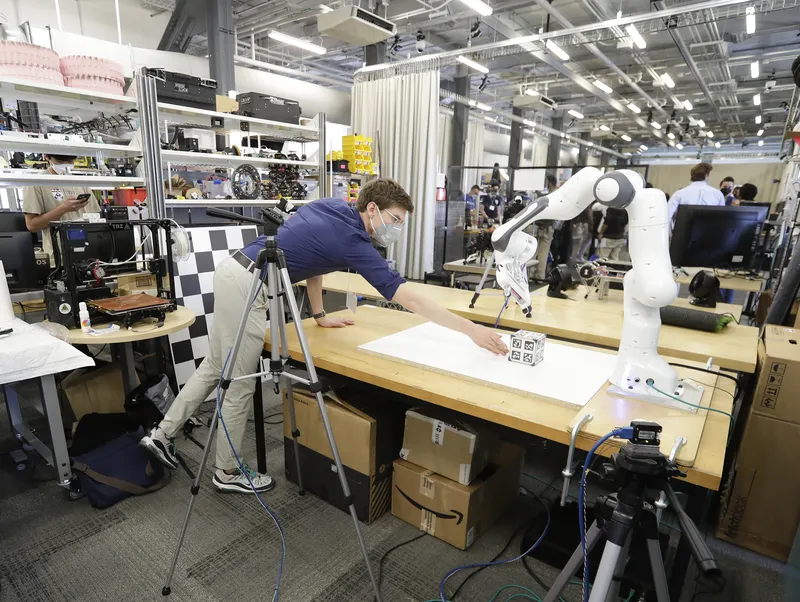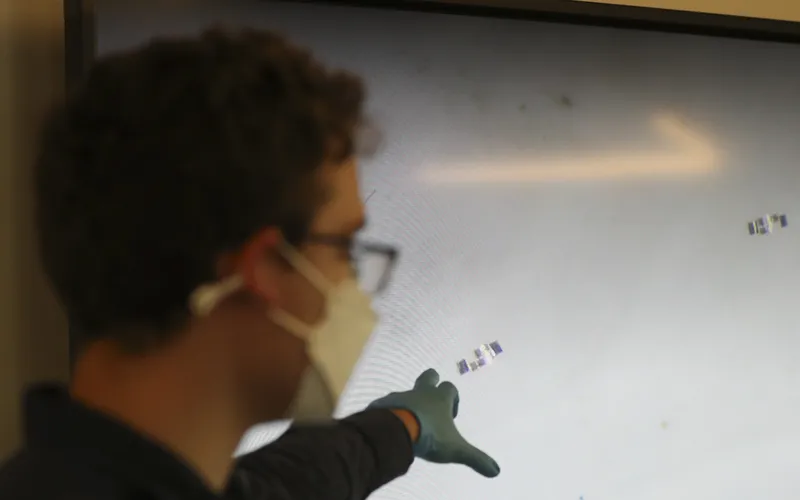
From Monday, May 23 through Friday May 27, Penn Engineering hosted the Institute of Electrical and Electronics Engineers‘ (IEEE) International Conference on Robotics and Automation (ICRA) at the Pennovation Center and the Pennsylvania Convention Center. One of the world’s major robotics conferences, ICRA brought roughly 4,500 guests from 89 countries to the city, in addition to virtual attendees, as the conference marked its first in-person event since 2019.
Vijay Kumar, Nemirovsky Family Dean of Penn Engineering, and George Pappas, UPS Foundation Professor and Chair of the Department of Electrical and Systems Engineering were the co-chairs of the conference, helping to organize academic talks, workshops, the robotics expo and contests, as well as tours on Penn’s campus, including the GRASP Lab, Singh Center and Penn Medicine.
The Philadelphia Inquirer’s Joseph DiStefano, who toured the Pennovation Center on the first day of the conference, described the assembly as “a robot lollapalooza,” quadrotors and two-legged machine beasts zooming about. He spoke with Kumar about the fundamental importance of robotics in engineering, and was able to get the scoop from several demonstrators, including from researchers at the Miskin Lab who are producing microrobots that may one day journey into the human body.
At the CMOS group of researchers, the robots are as thin as a human hair; a handful are displayed resting in a copper U.S. penny, in Lincoln’s ear. “That’s about 300 microns across. These are dumb robots: no sensing,” said Lucas Hanson, a Penn doctoral student who helps to fabricate them. “They move in response to illumination” and are expected to have medical applications, such as assembling gene therapies in the body. Sure enough, he turns up the light on the demonstrator, and the robots — short trains of square electrodes and solar cells — wiggle faster.

At one point on the conference’s third day at the Pennsylvania Convention Center, a group that included Tehcnical.ly reporter Paige Gross and Philadelphia Department of Commerce Director Anne Nadol hurried to keep up with Kumar as he guided them from booth to booth, introducing various Penn startups along the way. Taking a quick recoup, Gross and Kumar sat down to talk about the importance of developing a sound environment in Philly in which hardtech startups — startups that implement the intersection of hardware and software — can thrive.
“It’s known for eds and meds, but I find in the 21st century, if you want to be described as a progressive area, which we’d like to think that we are, you need to add to that complexity,” Kumar said. “We need to bring the know-how and the ecosystem. We have a supply of talent, but we need an ecosystem that retains talent. We need to do both, have more talent and build on the feedback loop.”
Did I really go to #ICRA2022 if I didn’t watch autonomous vehicles race themselves? pic.twitter.com/6pTpli2eK2
— Paige Gross ✨ (@By_paigegross) May 26, 2022
Read “Philly hosts a robot lollapalooza, attracting 4,500 roboticists and showing off devices that fly, swim and enter the body” at the Philadelphia Inquirer, and “What can Philly do to make a home for robotics to flourish? Scenes from ICRA 2022’s mad dash” at Technical.ly.
